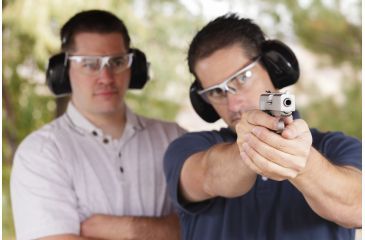Shooting and hunting can be extremely fun and are by far some of the safest sports you can become involved in because firearm safety is everyone's responsibility. In this guide, we will go over the basic gun safety rules and best practices for handguns, rifles, and shotguns to ensure you have a fun and safe experience with firearms.
![]()
Whether you intend to participate or observe, you need eye and ear protection. You can usually borrow or rent them at a shooting range, but investing in comfortable, high-quality eye and ear protection makes the overall experience much more enjoyable. Your eye protection should be ballistic-rated, and the ear protection can be ear muffs or earplugs. However, the best hearing protection for shooters is electronic hearing protection since it still allows you to hear safe background noises, such as people talking or range commands, without difficulty.
The basic rules of firearm safety work best as a system. Even if you fail to follow one, the others should still prevent an accident. Starting from when you remove a firearm from gun storage to when you're putting it away, following these safe gun handling rules will keep you and those around you safe.
Rule 1: Treat all guns as if they are loaded
The only way to be 100% sure a firearm is unloaded is to check for yourself. Even after you have checked the chamber and magazine, no one else around you can tell if the gun is loaded or not. By treating every firearm as a loaded gun, you will inherently have more respect and intent for how you are handling the firearm. Safety devices, such as chamber flags, are also useful for confirming if a firearm is loaded or not.
Rule 2: Never point the muzzle at anything that you are not willing to destroy
Even when you know for a fact that a firearm is unloaded, it is still very uncomfortable to have one pointed at you. In the worst-case scenario that a firearm is unknowingly loaded and discharged, you avoid doing damage by ensuring that the firearm is pointed in a safe direction at all times. For example, whenever you're not actively shooting at a target, either place the gun down with the barrel pointed outward, or if you're holding it, point it directly at the ground.
Rule 3: Keep your finger off the trigger until your sights are on target and you are ready to shoot
Flinches or reflexive squeezes can happen. By keeping your finger away from the trigger, you drastically reduce the chance of an accidental discharge. While mechanical safeties are highly recommended and should be used, they can always fail, so do not count on them alone to prevent an accident from lazy habits. Be intentional with your finger placement and movement around the trigger guard.
Rule 4: Be sure of your target and what is behind and around it
You should always be able to clearly identify your intended target. Far too many accidents result from people shooting at a noise in the dark or what they thought was an animal in the woods. Similarly, whether you miss or if the bullet passes through the target, you can end up hitting things around or behind your target. You need to be able to clearly identify what is behind your target and what is within close proximity to it.
By wearing protective gear and following the 4 Primary Rules of Gun Safety, gun owners can have a fun and safe time hunting, range training, or participating in any other shooting activities.






